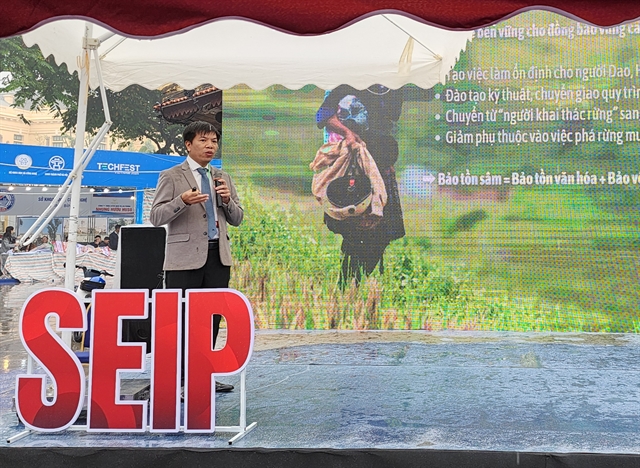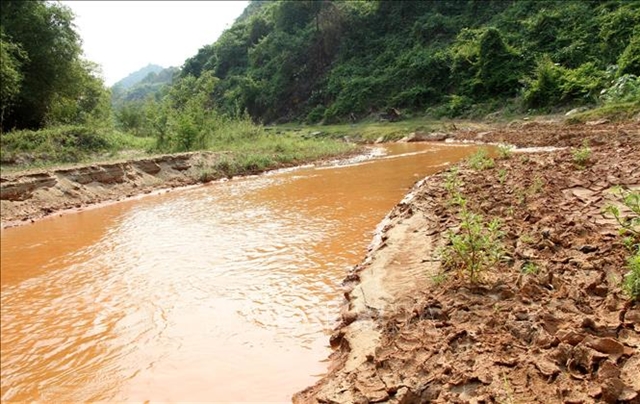 Society
Society

Mining activities in the central province of Nghệ An have contributed significantly to the province's socio-economic development, however, unreasonable exploitation coupled with a lack of relevant agencies' strict inspection has been causing serious pollution consequences on the Nậm Tôn River flowing through Quỳ Hợp District.

|
| The heavily polluted water of Nậm Tôn River flowing through Quỳ Hợp District, Nghệ An Province. VNA/VNS Photo |
NGHỆ AN Mining activities in the central province of Nghệ An have contributed significantly to the province's socio-economic development, however, unreasonable exploitation coupled with a lack of relevant agencies' strict inspection has been causing serious pollution consequences on the Nậm Tôn River flowing through Quỳ Hợp District.
With a length of tens of kilometres, the Nậm Tôn River used to be a source of life for thousands of people around the region. But now, the heavily polluted water source has turned red and cloudy, causing people's lives to be turned upside down the Tin tức (News) e-newspaper reported.
Liquid mud was deposited on the banks to form a layer several centimetres thick. After merging with the Nậm Huống River, this red water source has also extended down to the Nậm Choọng spring River before flowing to the Dinh River.
Quán Vi Cường, a resident of Quỳ Hợp District, said that in the past the river water was very clear and locals often used it directly. However, for many years now, the river water has been heavily polluted and cannot be used. Many rice areas on both sides of the river were forced to convert to other crops because they could not use this water for irrigation.
Nguyễn Viết Xuân, another resident, said that in order to have a source of drinking water, almost every family had to dig a well, which is very expensive. His family himself spent more than VNĐ8 million digging a 14m well to get water.
Further upstream the water is more turbid, containing more mud. Mud has accumulated in the river over the years; in some places, it is more than one meter thick and almost no fish can live there.
Although the water source has been polluted for a long time, locals have not been given any information about pollution indicators by the authorities.
The Nghệ An provincial Department of Natural Resources and Environment set up a water source monitoring point to monitor environmental changes but so far, the locality has not received pollution monitoring results.
Đinh Sỹ Khánh Vinh, Deputy Director of the Environmental Protection Sub-Department said data showed that in the past five years, water samples taken from Nậm Tôn River have TSS (total suspended solids) index that always exceeds Việt Nam's standards and tends to increase. In 2020, the TSS index appearing in the 3rd wave reached 808mg/l, while the standard was 30mg/l (26.93 times over).
The Quỳ Hợp District authorities have repeatedly affirmed that the pollution of the Nậm Tôn River was caused by mining activities. However, the inspection and detection work faced many difficulties, due to inadequate capacity and means.
The People's Committee of Quỳ Hợp District has issued a notice requesting all organisations and individuals to suspend the exploitation of underground water sources in the whole area of Na Hiêng, Công, Na Noong and Poong village, and Châu Hồng Commune from May 11.
Trần Đức Lợi, Vice Chairman of Quỳ Hợp District People's Committee, said that currently in Châu Tiến and Châu Hồng communes, some enterprises that were licensed to exploit tin ore but were detected to discharge wastewater causing turbidity in the Nậm Tôn River.
Through inspection, Quỳ Hợp District People's Committee found out two units did not comply with the approved environmental impact assessment report and they were administratively fined hundreds of millions of đồng.
Chairman of Nghệ An Provincial People's Committee Nguyễn Đức Trung said that they would not trade off the environment for economic development and must ensure sustainable development.
Local people hope that with the drastic direction of Nghệ An Province authorities, the pollution of Nậm Tôn River will be resolved completely so their life can return to normal soon.—VNS




